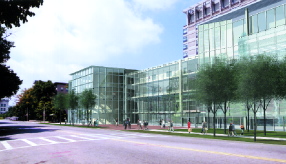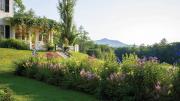The ceremonial groundbreaking for Harvard Medical School's new research building on February 1 assumes more than ordinary significance. Coming as it does about a century after the creation of the school's Boston campus, the huge new structure--430,000 square feet overall, including a quarter-million square feet of laboratory space--continues a major extension of research facilities. For the first time, the medical school is housing core preclinical departments across Longwood Avenue, as the new building anchors a "North Quad," remaking the familiar 1906 marble campus into a "South Quad." Even this extra space seems unlikely to exhaust the school's appetite for room to accommodate research scientists, suggesting still more expansion in the not-distant future.
 |
| New construction for the Medical School's "North Quad" will incorporate an auditorium and cafeterias along Avenue Louis Pasteur. |
| Harvard Medical School |
The research tower will be linked by pedestrian bridges to Harvard Institutes of Medicine, which opened in 1996 and houses researchers from the school's affiliated hospitals. Dean Joseph B. Martin made much of those links, saying that the future of medical research would be interdisciplinary, interdepartmental, interinstitutional, and collaborative. The "old walls" separating genetics from cell biology and pathology would be broken down, he said, as medical science moves from intensely reductionist techniques to those analyzing the connections from genes to enzymes to entire pathways of cellular activity. Those collaborations, symbolized by the proximity of the affiliates' laboratories, "will lead from fundamental discoveries to potential applications very quickly," said President Neil L. Rudenstine. He hailed a forthcoming "greatest period of discovery and invention in the history of medical science" in the next decade.
Whatever those discoveries may be, the medical school and its hospital affiliates already foresee the need for an additional 300,000 square feet of laboratory space. With the Longwood medical area increasingly built up, there appear to be two options for meeting the demand in the second half of the decade. If one of the area hospitals, such as Beth Israel Deaconess Medical Center, reduces its clinical space (see "Unhealthy Hospitals," March-April, page 29), a building might become available for renovation. Failing that, the medical school may join the lengthening queue of "customers" for the University's developable land in Allston.
Either way, this is one kind of Harvard growth welcomed, so far, by its surrounding communities. Noting the new research building's scientific significance as well as its role in creating local jobs and--through required "linkage" payments--housing, Boston mayor Thomas M. Menino, speaking at the February 1 event, called it "a day of celebration once again for the city working with Harvard."




